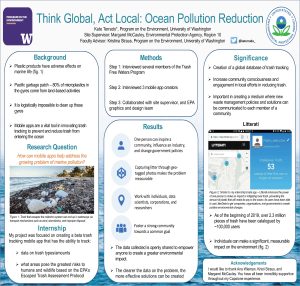Think Global, Act Local: Escaped Trash Reduction
The Pacific garbage patch is an example of the several swirling garbage zones in the oceans where all kinds of trash – including plastics, glass bottles, cigarette butts, and mattresses – end up. Both microplastics and whole plastic products have adverse effects on marine life. Reports suggest that 80% of microplastics in the gyres come from land-based activities, while the rest come from items that are lost or thrown overboard from ships. Garbage in the ocean come from trash from trash cans, the streets, and landfills that gets blown into sewers, rivers, or directly into the ocean. The purpose of this study was to create a mobile application with an ability to collect data on trash types, amounts, or what areas pose the greatest risks to humans and wildlife. This will support the Environmental Protection Agency’s (EPA) Trash Free Waters (TFW) Program to have a usable product that will increase the ability to track trash during site cleanup. To accomplish this task, I utilized my connections within several mobile application creators to be able to gather input on good practices for mobile experience design. I also utilized my connections with the members of TFW Program to ensure that its goals and needs in trash tracking are considered. The resulting mobile app provides an easy-to-use methodology for identifying a cleanup site, picking up the trash, and cataloguing it in a way that produces reliable data on the characteristics of trash as well as potential threats posed by waste.
